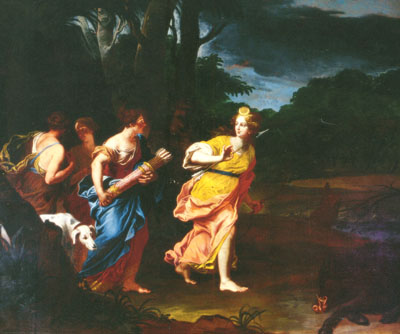
“Diana/Luna,” writes Kaiser, giving us the Greek and Roman names for the Moon (whom the Greeks also identified with Artemis, the sister of Apollo, their god of the sun, as opposed to Helios, the actual sun), “in her double function as goddess of the hunt and the moon, enters a clearing in the woods.” Her nymphs accompany her. “With an arrow in her raised right hand, she walks towards a wild boar, which has just been shot.” MM’s allegory of the Moon in LUNA is much more elaborate. To give only one set of details, the “L” of Light stands for the full of the moon, the “U” (letter and title), for the waning moon, the “N” of Need, for the crescent moon, and the “A” (letter and title), for the dark of the moon. The corner book, Light, is both solar and lunar, belonging to both stages, SOL and LUNA.
Under “Myth” Kaiser comments upon Luna as an erstwhile goddess of fertility and vegetation and notes her later identification with Eileithya, the goddess of childbirth. “It is reported that immediately after Diana’s own birth she assisted her mother Leto with the delivery of her twin brother Apollo.” She notes also a later identification of Artemis with the dark Hecate, “a goddess of magic, mysteries and death,” whom MM displaces into the complex of Hera/Shakti: see Her, the first book of HERMES and HERA. In Sentence of the Gods the horizontal LUNA stands above the horizontal HERMES, for whom the Moon was his planet. Beneath LUNA and HERMES lies the horizontal APHRODITE. Thus are two examples of what Kaiser calls “quintessential woman” related to one another.
Here, as with the Sun, it is the moral aspect of the allegory that is emphasized.